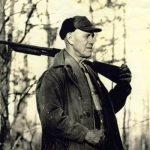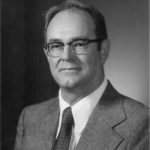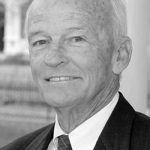In various roles with Audubon Arkansas, including vice president and executive director, Fennell was an outspoken advocate for native bird species, flyways and nesting habitat throughout Arkansas. During her tenure with the organization, she was instrumental in securing funding for several state initiatives including environmental programs in the state’s schools, water quality education, energy policy and habitat restoration.
Uncategorized
Wallace Claypool – 2012
Build it and they will come.
Wallace Claypool used this plan successfully with ducks a half-century before the phrase was a key component in a popular baseball movie.
Claypool’s Reservoir in east Arkansas launched the most reproduced wildlife photograph of all times in Arkansas, and it was the site of an early television milestone program. All along, from its construction in 1940 to today, the reservoir has been a proven and reliable hotspot for mallards and many other species when ducks come south for the winter.
So strong was the reservoir’s appeal to ducks that some waterfowlers and commercial duck operations shook fists in Wallace Claypool’s direction when his reservoir had ducks and theirs did not. “Claypool’s got a half-million ducks on his place, and we don’t have any.”
Claypool’s Reservoir covers 1,350 acres on the Wild Acres tract, 3,500 total acres a few miles east of Weiner in Poinsett County, that Claypool bought in 1941. He built the reservoir next to L’Anguille River for the express purpose of enticing ducks. The reservoir is shallow and timber filled. It has been a duck magnet from its inception in the style of the east Arkansas bottomland hardwood duck hunting made internationally famous over the years.
Wallace Claypool was born in 1886 and died in 1973 at the age of 87. He successfully managed a Memphis automobile dealership beginning in 1915 then partnered with Hugh Jetton in launching Bluff City Buick Co., in 1922. Times were booming in Memphis then, and Buicks were in demand. Claypool soon became a leader in a major Memphis bank and with the city’s Chamber of Commerce.
Claypool, personally strong on physical fitness, was a competitive amateur golfer then got into duck hunting in 1925. He had memberships in several east Arkansas duck clubs, including Wapanocca and Hatchie Coon, and developed the related skills as well as intense interest in habitat for wintering ducks.
In 1940, he won the World Duck Calling Championship at Stuttgart, and the next year was steered to land for sale by Fritz Rosenwald, who had declined Claypool’s offer to buy Rosenthal’s nearby land.
Claypool planted millet and other duck foods, but the hundreds of thousands of ducks that used the reservoir roamed widely in daytime to find food, disproving the allegation that “Claypool is hoarding the ducks.”
In 1956, Claypool’s Reservoir hit national television with a bang.
The most popular program of the time was Dave Garroway’s Wide Wide World. It had done a segment on catfishng in Arkansas, and Tom Mull, communications official with the Arkansas Game and Fish Commission, pitched the idea of a live duck hunt for Garroway’s program. It was accepted, and Mull assigned George Purvis, his assistant, to make arrangements. Purvis had taken an iconic black and white photo of hundreds of thousands of ducks in the water and in the air at Claypool’s Reservoir.
The challenges were immense for the program to air on Dec. 23. Access to the reservoir was by muddy roads. Two miles of power cables had to be strung for the operation of the large, bulky cameras along with six telephone lines.
But would the ducks be there?
Yes. And at 3:14 p.m. with Garroway’s program rolling, crews directed by Purvis fired a rocket, and an estimated 350,000 ducks sprang into the air with some cameras focused on two hunters, renowned shotgunner Herb Parsons and his 12-year-old son. So enthralled were the New York producers of the Garroway show that they kept the Arkansas images rolling and cut back other scheduled programs. Garroway closed out the live duck hunt by saying, “Now if you will brush the duck feathers off your sofa, we’ll go on with the rest of our program.”
Claypool had strict duck hunting concepts for his reservoir. It was hunted only in mornings and only three days a week – Wednesdays, Saturdays and Sundays.
He retired and sold Claypool’s Reservoir in 1966 to four Memphis friends, all enthusiastic duck hunters -Bayard Boyle, Snowden Boyle, Toof Brown and Norfleet Turner. But Claypool and wife Sally continued to live on Wild Acres until shortly before his death.
Carl Hunter – 2008
Carl Hunter, who died in 2005, may have achieved as much renown in his retirement career than as a long-time leader in wildlife biology and conservation. Hunter turned his hobbies of photography and wildflowers into a popular book and into demand as a speaker to garden and other clubs. He was a leader in Arkansas’ deer restoration, joining the Arkansas Game and Fish Commission in 1945, leaving to help industrialist Edgar Monsanto Queeny develop Wingmead in eastern Arkansas then returning to AGFC and becoming assistant director until retirement in 1986.
Jim Hill – 2007
Jim Hill is a rancher and a veteran state legislator with a lifelong interest in hunting, camping and other outdoor activities. He drafted the legislation in 1996 that led to the passing of today's Conservation Sales Tax that has greatly bolstered Arkansas State Parks, Game and Fish Commission, Natural Heritage Commission and Keep Arkansas Beautiful.
Cathie Remmel Matthews – 2006
A member of a Little Rock family long prominent in outdoor activities and, as director of the Department of Arkansas Heritage, she has obtained dozens of environmentally and historically significant locales in the state to be conserved, protected and enjoyed by outdoor enthusiasts.




